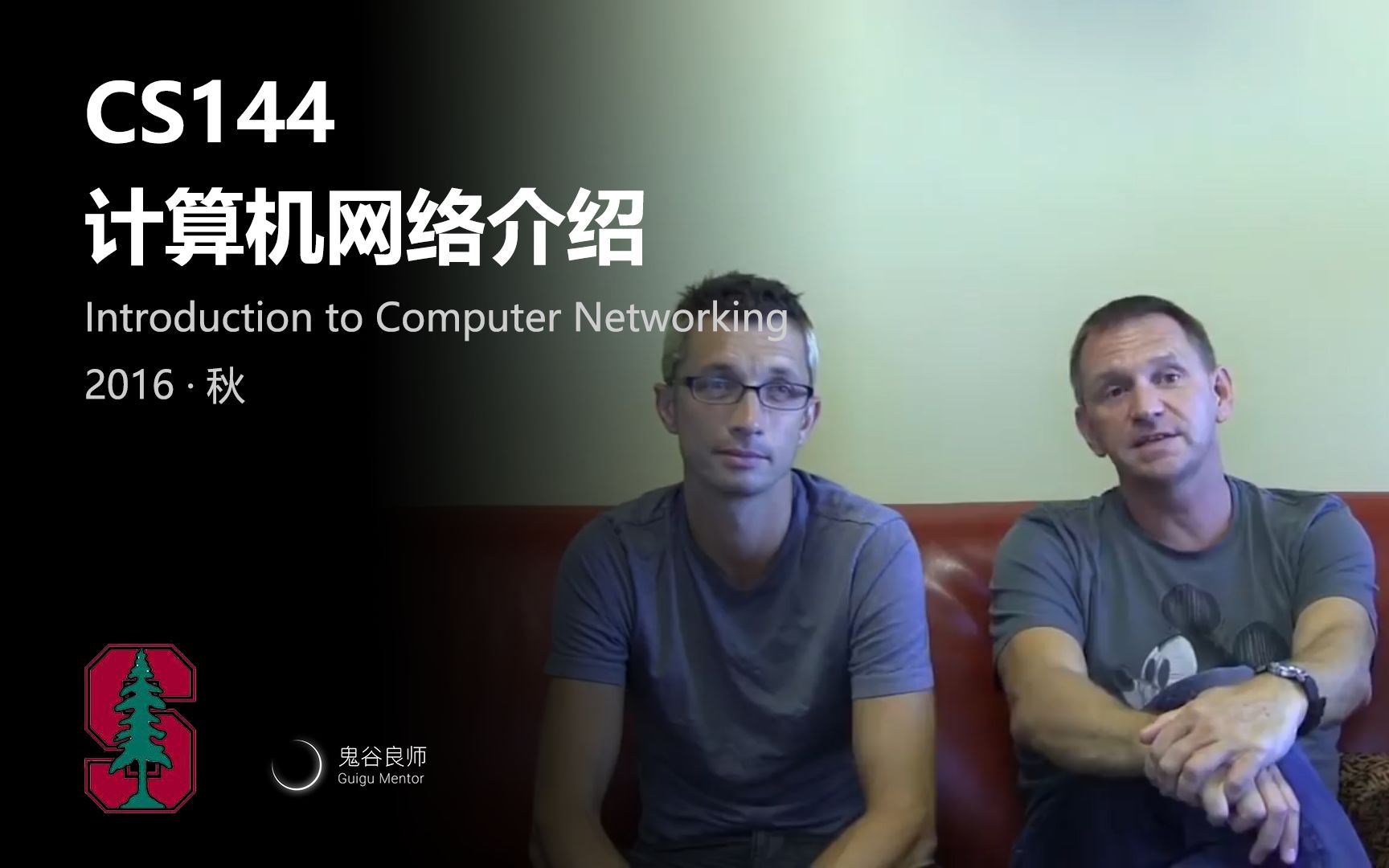- 在线播放
- 分集下载
- 1-0 The Internet and IP Introduction
- 1-1 A day in the life of an application
- 1-2 The four layer Internet model
- 1-3 The IP service model
- 1-4 A Day in the Life of a Packet
- 1-5 Packet switching principle
- 1-6 Layering principle
- 1-7 Encapslation principle
- 1-8a byte order
- 1-8b byte order
- 1-8c byte order
- 1-8d byte order
- 1-9a IPv4 addresses
- 1-9b IPv4 addresses
- 1-9c IPv4 addresses
- 1-9d IPv4 addresses
- 1-10a Longest prefix match (LPM)
- 1-10b Longest prefix match (LPM)
- 1-10c Longest prefix match (LPM)
- 1-11 Address Resolution Protocol (ARP)
- 1-12 The Internet and IP Recap
- 2-0 Transport (intro)
- 2-1 TCP service model
- 2-2 UDP service model
- 2-3 ICMP service model
- 2-4 End to End Principle
- 2-5 Error detection
- 2-6a Finite state machines 1
- 2-6b Finite state machines 2
- 2-6c Finite state machines 3
- 2-6d Finite state machines 4
- 2-7 Stop and wait
- 2-8 Sliding window
- 2-9 Reliable comm --- Retransmission strategies
- 2-10 Reliable comm --- TCP header
- 2-11 Reliable comm --- Connection setup and teardown
- 2-12 Transport (recap)
- 3-0 Packet Switching
- 3-1 The History of Networks The History of the Internet
- 3-2 Packet Switching - Principles What is packet switching
- 3-3Packet Switching - Principles Terminology End to End Delay and Queueing delay
- 3-4 Packet Switching - Principles Playback buffers
- 3-5 Packet Switching - Principles Simple Deterministic Queue Model (revised)
- 3-5a Simple Queueing Model Example
- 3-6 Packet Switching - Principles Queueing Model Properties
- 3-7 Packet Switching - Practice Switching and Forwarding (1)
- 3-8 Packet Switching - Practice Switching and Forwarding (2)
- 3-9 Packet Switching - Principles Rate guarantees
- 3-10 Packet Switching - Principles Delay Guarantees (revised)
- 3-10a Delay Guarantees Example
- 3-11 Packet Switching (recap)
- 4-0 Congestion Control
- 4-1 Congestion Control - Basics
- 4-2 Congestion Control - Basics 2
- 4-3 Congestion Control - Dynamics of a single AIMD flow
- 4-3a Single AIMD flow worked example
- 4-4 AIMD Multiple Flows
- 4-5 TCP Tahoe
- 4-5a Congestion Control - TCP Tahoe
- 4-6 TCP RTT Estimation
- 4-6a Congestion Control - RTT Estimation and Self-Clocking
- 4-7 Congestion Control - TCP Reno and New Reno
- 4-7a TCP Reno
- 4-8 Congestion Control - AIMD
- 4-9 Skills --- Reading and RFC
- 4-11 Congestion Control
- 5-0 Applications and NATs
- 5-1 NATs - Introduction
- 5-2 NATs - Types
- 5-3 NATs - Implications
- 5-4 Nats - Operation
- 5-5a HTTP
- 5-5b HTTP Quiz 1 Intro
- 5-5c HTTP Quiz 1 Explanation
- 5-5d HTTP Quiz 2 Intro
- 5-5e HTTP Quiz 2 Explanation
- 5-6 HTTP11 Keep-alive
- 5-7 BitTorrent
- 5-8 DNS 1
- 5-9 DNS 2
- 5-10 DNS 3
- 5-11 DHCP
- 5-12 Applications and NATs (recap)
- 6-0 Routing
- 6-1 Routing - Flooding source routing and spanning trees
- 6-2 Routing - Bellman Ford
- 6-3 Routing - Dijkstra
- 6-4 Routing - Internet (RIP OSPF) ASs
- 6-5 Routing - BGP
- 6-6 Routing - Multicast
- 6-7 Routing - Spanning Tree
- 6-8 IPv6
- 6-9 Routing
- 7-0 Lower Layers
- 7-1 Physical and Link Principles - Shannon Capacity and Modulation
- 7-2 Physical and Link Principles - Bit Errors
- 7-3 Physical and Link - Principles clocks
- 7-4 Physical and Link Principles - FEC and Reed-Solomon
- 7-5 Physical and Link - Principles MAC and CSMACD
- 7-6 Physical and Link - Practice Ethernet
- 7-7 Wireless - How Its Different
- 7-8 Wireless - Principles MAC
- 7-9 Wireless - Principles CSMACA
- 7-10 Wireless - Principles RTSCTS
- 7-11 Wireless - Principles WiFi
- 7-11a Fragmentation
- 7-11b Forward Error Correction
- 7-12 Lower Layers (recap)
- 8-0 Security
- 8-1 Introduction to Network Security
- 8-2 Layer 2 Attacks
- 8-2a MAC Overflow Attack
- 8-2b DHCP Attack Demo
- 8-2c Demo SSH Man in the Middle Attack
- 8-2d TCP Hijack
- 8-3 Layer 3 Attacks
- 8-4 Security V - Denial of Service
- 8-5 Security Principles
- 8-6a Confidentiality
- 8-6b Confidentiality
- 8-6c Confidentiality
- 8-6d Confidentiality
- 8-6e Confidentiality
- 8-6f Confidentiality
- 8-6g Confidentiality
- 8-6h Confidentiality
- 8-7 Integrity
- 8-8 Public Key Cryptography
- 8-9 Certificates
- 8-10a TLS
- 8-10b TLS
- 8-10c TLS
- 8-10d TLS
- 8-11 Security
- 9-1 Jon Peterson Interview -- SIP and Security
- 9-2 Kevin Fall
- 9-3 Tom Edsall Interview -- DC Switches
- 9-4 Nandita Interview
- 9-5 David Ward
- 9-6 BGP Putting the Inter in Internet Professor Jennifer Rexford Princeton
- 9-7 Sanjit Biswas CEO of Meraki (interviewed by Nick M)
- 9-8 Dan Boneh Interview -- Security
- 9-9 Reed Hundt on security and openness
CS144计算机网络介绍的相关介绍
同步课件:https://github.com/khanhnamle1994/computer-networking
笔者提供的这部计算机网络技术教程为大家介绍了计算机网络的概述、计算机网络体系结构、数据通信技术、局域网、网络设备、广域网络技术、Internet技术及应用、网络操作系统、实战组网和网络安全技术等内容。
计算机网络技术是通信技术与计算机技术相结合的产物。计算机网络是按照网络协议,将地球上分散的、独立的计算机相互连接的集合。连接介质可以是电缆、双绞线、光纤、微波、载波或通信卫星。计算机网络具有共享硬件、软件和数据资源的功能,具有对共享数据资源集中处理及管理和维护的能力。
计算机网络包括计算机和网络两部分.其中计算机又称电子计算机,俗称电脑,是一种能够按照程序运行,自动、高速处理海量数据的现代化智能电子设备。由硬件和软件所组成,没有安装任何软件的计算机称为裸机。常见的形式有台式计算机、笔记本计算机、大型计算机等,较先进的计算机有生物计算机、光子计算机、量子计算机等。而网络就是用物理链路将各个孤立的工作站或主机相连在一起,组成数据链路,从而达到资源共享和通信的目的。所以计算机网络是指将地理位置不同的多台自治计算机系统及其外部网络,通过通信介质互联,在网络操作系统和网络管理软件及通信协议的管理和协调下,实现资源共享和信息传递的系统.
计算机网络技术实现了资源共享。人们可以在办公室、家里或其他任何地方,访问查询网上的任何资源,极大地提高了工作效率,促进了办公自动化、工厂自动化、家庭自动化的发展,计算机网络是服务现代科技的开端。
21世纪已进入计算机网络时代。计算机网络极大普及,计算机应用已进入更高层次,计算机网络成了计算机行业的一部分。新一代的计算机已将网络接口集成到主板上,网络功能已嵌入到操作系统之中,智能大楼的兴建已经和计算机网络布线同时、同地、同方案施工。随着通信和计算机技术紧密结合和同步发展,我国计算机网络技术飞跃发展。





